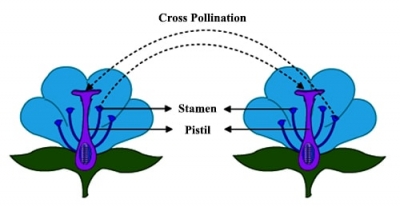
Everything inside a flower is arranged to make pollination possible. This operation involves the transfer of pollen from the anthers of the stamens to the pistil.
It is very rare, however, that the pollen produced by one flower is used to fertilize the pistil in the same flower. Instead, flowers are designed to obtain pollen from other plants and their flowers. This enables better seeds and fruits to be produced and is known as cross-pollination. Its usefulness was demonstrated by the great naturalist, Charles Darwin, in 1859.
Cross-pollinating flowers occasionally have their pollen waiting on the stamens before the pistil is ready to take it, or the pistil may be ready but the stamens have produced no pollen. Some plants produce flowers with’ stamens only (male flowers) while others produce flowers with only pistils (female flowers). These plants are pollinated with the help of the wind which blows the pollen grains through the air.
Such plants produce huge amounts of pollen because much of it is lost in the air and only a small quantity finally reaches its proper destination.
Picture Credit : Google

